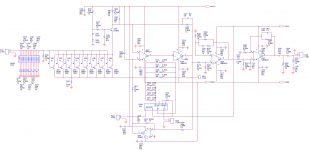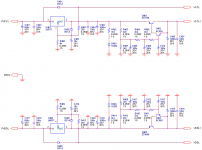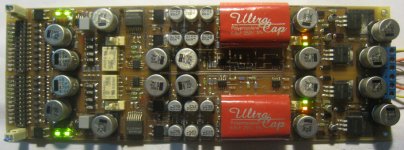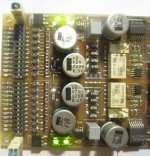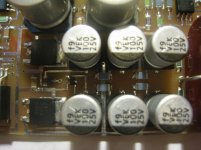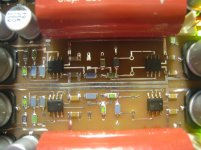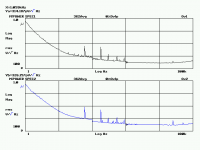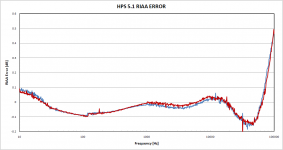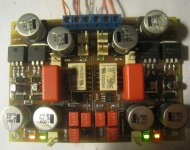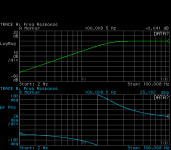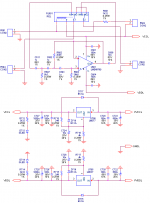And here's probably the last in the HPS series.
HPS 5.1 is built on the same foundation as HPS 5.0, using the same SMD technology (which, by the way, I find much easier to work and rework compared to through hole; the flip side is the rather high cost of good quality 1206 SMD passive components).
There are though some significant improvements. The head amp follows the same simple architecture, an ultra low noise transconductance stage, followed by a high gain transimpedance stage and a servo, to allow DC coupling to the output. The LF open loop gain is still gm*R203 (see HPS51.png), where gm is the tranconductance stage gain, approximately 2*Id/Vt, where Id is the total JFETs drain current (~90mA) and Vt is the BF862 pinch voltage (~0.8V). However, the low noise stage is now cascoded using a low noise ZXT690 power device. The JFETs Vds is about 3V. At this voltage, BF862 does not have any hot carrier injection noise. The cascode reference (~3.6V) is provided by two LEDs, decoupled for low noise by a large electrolytic.
To greatly improve the input stage PSRR, two changes were made. First, the lead-lag compensation network R206/C206 is now connected to the positive supply rather than to the ground. At the same time, the non inverting input of the transimpedance stage opamp is now decoupled to the same positive supply by C227. The net effect is that, for a rather large frequency range certainly well below and over the audio range), the AC voltage gain of the transimpedance stage is very low; any noise or other perturbations appear as common mode for the opamp, and therefore they are rejected. A PSRR of ~-50dB is obtained.
This, coupled with the same noise cancelling power buffer (using a Sziklay current feedback series regulator, that greatly reduces the equivalent Rbb of the power device, see HPS51-PS.png) leads an overall PSRR performance comparable to HPS 3.1 and HPS 4.2, but with a much simpler solution.
This is obvious when looking at the noise performance (see HPS51-noise.png). While HPS 5.0 had the 60Hz harmonic noise rather on the high side, HPS 5.1 has not more than 8nV equivalent input 60Hz noise, which is excellent. The 60Hz harmonic noise is actually not injected from the power supply, but from the magnetic coupling with the environment. The overall noise is around 0.3nV/rtHz and the corner frequency is typical for JFETs, some 300Hz.
The RIAA stages are identical with HPS 5.0, and so is the power supply. The measured RIAA precision is attached, it is under 0.1dB to well over the audio range, see RIAA.png below. The opamps are the National LME49870, supporting +/-22V. As usual, the Neumann pole is implemented. I chosed to avoid implementing a high pass 20Hz rumble filter in the preamp, this can be externally attached at the output.
The head amp gain is switchable via a NEC low signal relay (one of the best I was able to find, actually slightly beats the Panasonic devices) for a total of 60dB (MC) and 48dB (MM). Switching the head amp gain actually preserves the dynamic range of 32dB when switching to MM.
As I said, this is probably the last RIAA pre that I am building. In a sense, the circle is now closed. I started from the Colins pre (HPS 1.0), improved the Colins architecture (HPS 2.0), developed a supersymmetrical complementary JFET head amp architecture for the ultimate performance (HPS 3.1), then I designed and built a series of ultra low noise bipolar preamps, having virtually zero adjustable input bias current (so all DC coupling to the output was possible) as first HPS 4.1 (using Jung regulators and local buffers) and then HPS 4.2 (using TMC compensated local shunt regulators). Finally, I have succesfully tried to greatly reduce the complexity without impacting the performance; HPS 5.1 has virtually the same (or even better in some respects) to HPS 3.1, and uses low noise JFETs in current production, selling for pennies. The power supply went from Jung regulators, to high performance shunt regulators, to ultra simple LM317/LM337 plus a noise cancelling power buffer.
Which one is the best? Time will tell, I like best the HPS 5.1. Secondly comes HPS 4.2 (the bipolar with shunt regulators) and finaly HPS 3.1. But then of course, I am biased, and didn't do any blind test to prove my preferences .
.
Some pictures of the construction are below (HPS51.jpg, HPS51-IS the head amp detail, HPS51-PB.jpg the power buffer detail, HPS51-RIAA.jpg the RIAA stages). The Gerbers will be available for free on my web site, as soon as I'll find the time for an update.
EDIT: if anybody is wondering, HPS5.1 and HPS 5.0 are 100% hand soldered using a Weller fine tip and 0.5mm zero residue flux 63/37 solder.
HPS 5.1 is built on the same foundation as HPS 5.0, using the same SMD technology (which, by the way, I find much easier to work and rework compared to through hole; the flip side is the rather high cost of good quality 1206 SMD passive components).
There are though some significant improvements. The head amp follows the same simple architecture, an ultra low noise transconductance stage, followed by a high gain transimpedance stage and a servo, to allow DC coupling to the output. The LF open loop gain is still gm*R203 (see HPS51.png), where gm is the tranconductance stage gain, approximately 2*Id/Vt, where Id is the total JFETs drain current (~90mA) and Vt is the BF862 pinch voltage (~0.8V). However, the low noise stage is now cascoded using a low noise ZXT690 power device. The JFETs Vds is about 3V. At this voltage, BF862 does not have any hot carrier injection noise. The cascode reference (~3.6V) is provided by two LEDs, decoupled for low noise by a large electrolytic.
To greatly improve the input stage PSRR, two changes were made. First, the lead-lag compensation network R206/C206 is now connected to the positive supply rather than to the ground. At the same time, the non inverting input of the transimpedance stage opamp is now decoupled to the same positive supply by C227. The net effect is that, for a rather large frequency range certainly well below and over the audio range), the AC voltage gain of the transimpedance stage is very low; any noise or other perturbations appear as common mode for the opamp, and therefore they are rejected. A PSRR of ~-50dB is obtained.
This, coupled with the same noise cancelling power buffer (using a Sziklay current feedback series regulator, that greatly reduces the equivalent Rbb of the power device, see HPS51-PS.png) leads an overall PSRR performance comparable to HPS 3.1 and HPS 4.2, but with a much simpler solution.
This is obvious when looking at the noise performance (see HPS51-noise.png). While HPS 5.0 had the 60Hz harmonic noise rather on the high side, HPS 5.1 has not more than 8nV equivalent input 60Hz noise, which is excellent. The 60Hz harmonic noise is actually not injected from the power supply, but from the magnetic coupling with the environment. The overall noise is around 0.3nV/rtHz and the corner frequency is typical for JFETs, some 300Hz.
The RIAA stages are identical with HPS 5.0, and so is the power supply. The measured RIAA precision is attached, it is under 0.1dB to well over the audio range, see RIAA.png below. The opamps are the National LME49870, supporting +/-22V. As usual, the Neumann pole is implemented. I chosed to avoid implementing a high pass 20Hz rumble filter in the preamp, this can be externally attached at the output.
The head amp gain is switchable via a NEC low signal relay (one of the best I was able to find, actually slightly beats the Panasonic devices) for a total of 60dB (MC) and 48dB (MM). Switching the head amp gain actually preserves the dynamic range of 32dB when switching to MM.
As I said, this is probably the last RIAA pre that I am building. In a sense, the circle is now closed. I started from the Colins pre (HPS 1.0), improved the Colins architecture (HPS 2.0), developed a supersymmetrical complementary JFET head amp architecture for the ultimate performance (HPS 3.1), then I designed and built a series of ultra low noise bipolar preamps, having virtually zero adjustable input bias current (so all DC coupling to the output was possible) as first HPS 4.1 (using Jung regulators and local buffers) and then HPS 4.2 (using TMC compensated local shunt regulators). Finally, I have succesfully tried to greatly reduce the complexity without impacting the performance; HPS 5.1 has virtually the same (or even better in some respects) to HPS 3.1, and uses low noise JFETs in current production, selling for pennies. The power supply went from Jung regulators, to high performance shunt regulators, to ultra simple LM317/LM337 plus a noise cancelling power buffer.
Which one is the best? Time will tell, I like best the HPS 5.1. Secondly comes HPS 4.2 (the bipolar with shunt regulators) and finaly HPS 3.1. But then of course, I am biased, and didn't do any blind test to prove my preferences
Some pictures of the construction are below (HPS51.jpg, HPS51-IS the head amp detail, HPS51-PB.jpg the power buffer detail, HPS51-RIAA.jpg the RIAA stages). The Gerbers will be available for free on my web site, as soon as I'll find the time for an update.
EDIT: if anybody is wondering, HPS5.1 and HPS 5.0 are 100% hand soldered using a Weller fine tip and 0.5mm zero residue flux 63/37 solder.
Attachments
Last edited:
My best wishes for the future.
Hello Syn08:
thank you for sharing all your HPS designs. You have made an outstanding achievement, and I find that you deserve respect for your excellent work and also you willingness to share what you know!
It is a pity that there will be no more HPS designs. But I guess you now need new challenges. Maybe a discrete balanced in / bal out DC coupled IV converter could be such a new challenge? There must be more people looking for such a design than there are people looking for a superb RIAA amplfier....
My best wishes for the future.
I will keep an eye on your new forum
Sigurd
Hello Syn08:
thank you for sharing all your HPS designs. You have made an outstanding achievement, and I find that you deserve respect for your excellent work and also you willingness to share what you know!
It is a pity that there will be no more HPS designs. But I guess you now need new challenges. Maybe a discrete balanced in / bal out DC coupled IV converter could be such a new challenge? There must be more people looking for such a design than there are people looking for a superb RIAA amplfier....
My best wishes for the future.
I will keep an eye on your new forum
Sigurd
Yes, Syn08. A number of us thank you for sharing very good work.
(Even if you ARE now tempting me to put my HPS3.1 on the shelf)
I would be very interested in your findings on "good quality 1206 SMD passive components". Any specifics you have found and criteria you are using - or anecdotal advice - would be very much appreciated.
I made it as far as the gate stopper inductors in your latest before I relalized that I had never considered coils in a low level, low frequency application...
- ken
(Even if you ARE now tempting me to put my HPS3.1 on the shelf)
I would be very interested in your findings on "good quality 1206 SMD passive components". Any specifics you have found and criteria you are using - or anecdotal advice - would be very much appreciated.
I made it as far as the gate stopper inductors in your latest before I relalized that I had never considered coils in a low level, low frequency application...
- ken
Yes, Syn08. A number of us thank you for sharing very good work.
(Even if you ARE now tempting me to put my HPS3.1 on the shelf)
I would be very interested in your findings on "good quality 1206 SMD passive components". Any specifics you have found and criteria you are using - or anecdotal advice - would be very much appreciated.
I made it as far as the gate stopper inductors in your latest before I relalized that I had never considered coils in a low level, low frequency application...
- ken
Hi Ken,
Thanks for the nice words. Perhaps it is time to put the HPS3.1 at rest
First, I am working with 1206 parts only; reason is the status of my personal vision instruments
Secondly, resistors need to be (mostly) thin or metal film, thick film won't cut it, they are about the quality (excess noise, stability) of carbon film resistors and you certainly don't want those in an ultra-low noise preamp.
Third, you need at least 1% precision and a good selection of odd values, in particular in the RIAA sections.
Fourth you want those part in stock, at least for me waiting 6 weeks for 5 resistors doesn't make any sense.
These being said, Mouser appears to be the only option as a distributor for small quantities. Digikey has little in stock (and has minimum quantities of 10) while Newark has even less...
Unfortunately, Mouser is stocking mostly 0.1% parts. That's not bad (you saw the RIAA precision and matching in HPS5.1) but prices are really high: $0.6-0.8 per pc. For low values (under 50 ohm) you have to go with the "current sensing resistors" or wirewound, and those are even more expensive.
For whatever reason, 1% C0G caps used in the input load and the RIAA correction are absurdly expensive. I had to pay up to $3.50 per pc.!!! That's really funny, because the leaded parts from the same manufacturer (I think it was Murata) cost pennies. I have a stock of those leaded parts, and I cracked a few; to my surprise, inside there's a SMD part with soldered leads, everything molded in a colored ceramic goo. Does it make any sense?

Polypropylene SMD parts are usually not commonly available; you'll notice I had to use leaded parts for the RIAA and frequency compensation (100nF).
Those inductive gate stoppers are a good protection against HF oscillations. Without them, the risk of getting a 100MHz+ oscillator is really high. Of course, at audio frequencies those coils have virtually zero impedance AND (most important) zero added noise. Again funny enough, these SMD 1uH air coils are dirt cheap (you would think they should be more expensive than resistors, isn't it?). BTW, the headamp (from HPS 3.1 and up) is typical for gain stage that can barely be prototyped (breadboard, or air, or wire wrap). Not only the unity loop gain is high (3-5MHz) but also the high impedances and sensitivity to ground loops and parasitic inductances makes prototyping difficult. It can be done, but with very special counter measures (I had e.g. to guard the high impedance junctions around the feedback loop with grounded breadboard strips, while still minimizing the length of the wire straps).
EDIT: there's one thing that I'll add soon: a rumble filter. While this can easily be integrated with the entire preamp, I prefer to build it as a separate module, that can be inserted (or bypassed) at the HPS output via low signal relays. It's essentially a 20Hz 3-pole (60dB/decade) Sallen-Key high pass filter, built around the same LME49870 high voltage opamps (to conserve the entire dynamic range).
Last edited:
EDIT: there's one thing that I'll add soon: a rumble filter. While this can easily be integrated with the entire preamp, I prefer to build it as a separate module, that can be inserted (or bypassed) at the HPS output via low signal relays. It's essentially a 20Hz 3-pole (60dB/decade) Sallen-Key high pass filter, built around the same LME49870 high voltage opamps (to conserve the entire dynamic range).
Done, works as expected. A 3rd order Butterworth 20Hz high pass filter, provides a group delay of under 20mS, so it's not affecting the low frequency response (according to the most demanding subjective tests, see Holman et. al.), while providing a 60dB/decade attenuation. Arm resonances, DC output flickers, etc... are greatly attenuated. Schematic (filter plus power supply, one channel only) is also attached.
Attachments
I have updated my web site Synaesthesia with the full HPS 5.1 schematics and Gerber files. The rumble filter and the overall measurement results to follow soon, time permitting.
This could be a long shot, has anyone got the skills and time to get some of these PCB's built. I dont know if there is enough interest to make it worthwhile. Id be happy to pay upfront if we can get enough interest.
Of course this is only if it is ok with the designer, Syn08!
Of course this is only if it is ok with the designer, Syn08!
You should learn to make PCB yourself. It is not that complicated. Start reading tutorilals abaout it. Internet is full of them.This could be a long shot, has anyone got the skills and time to get some of these PCB's built. I dont know if there is enough interest to make it worthwhile. Id be happy to pay upfront if we can get enough interest.
Of course this is only if it is ok with the designer, Syn08!
Buying factory made boards is not real DIY. It is more interesting building something out of raw material. It is not a matter of costs, but a real pleasure.
DIY builders become lazy.
Some of us don't have the time to make our own pcbs. As much as I'd like to, I barely have space to solder in my house and with little uns running around haz-chem is a no-no. So for some of us group buys of brilliant designs with help from other diyers is all we have to keep us from the grasp of the merciless retailers.
Syn, I'd be willing to help out however I can if you were prepared to allow a group buy on this. Paying per board, helping with set-up costs with a pcb fab, whatever would help make this a relaity for those of use who have keenly followed your various Phonostage endeavours over the years.
Syn, I'd be willing to help out however I can if you were prepared to allow a group buy on this. Paying per board, helping with set-up costs with a pcb fab, whatever would help make this a relaity for those of use who have keenly followed your various Phonostage endeavours over the years.
Buying factory made boards is not real DIY.
I agree. In fact, I make all my own transformers, resistors, inductors and capacitors as well. I feel this is the real spirit of DIY.
Hi all
As you may have noticed syn08 is in the Sin Bin and not able to post a message.
This is the status:
He don’t have time nor interest in organizing a group buy for the HPS 5.1 boards/parts (nor any of his other projects).
You CAN grab all the information needed from his web site for free, for any non-commercial DIY use.
Note: The formal copyright statement is on the front page of his website
HERE
If anybody wants to organize a group buy, based on the information he is providing, you are free to do so.
He can offer only very limited support over email
PS! (and don't hold your breath for quick responses).
As you may have noticed syn08 is in the Sin Bin and not able to post a message.
This is the status:
He don’t have time nor interest in organizing a group buy for the HPS 5.1 boards/parts (nor any of his other projects).
You CAN grab all the information needed from his web site for free, for any non-commercial DIY use.
Note: The formal copyright statement is on the front page of his website
HERE
If anybody wants to organize a group buy, based on the information he is providing, you are free to do so.
He can offer only very limited support over email
PS! (and don't hold your breath for quick responses).
Nice, luvdunhill. You have a big business chance selling your home made components to audio DIY builders. Your capacitors are probably toilet paper in sunflower oil type. Better than teflon in valve circuits. Go on luvdy!I agree. In fact, I make all my own transformers, resistors, inductors and capacitors as well. I feel this is the real spirit of DIY.
- Home
- Source & Line
- Analogue Source
- Hps 5.1
